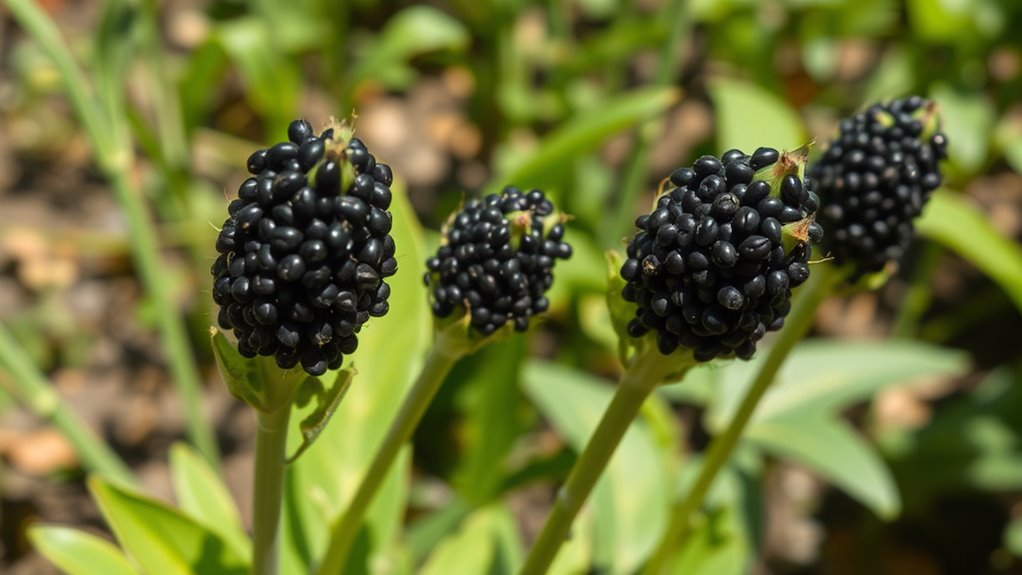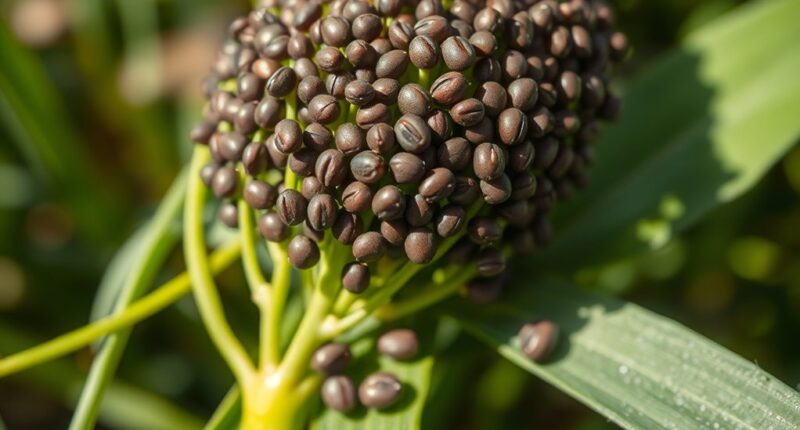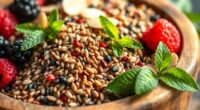You can tell when chia seeds are ready to harvest by observing the seed heads; they should turn light brown or tan, and the plants will look dried out and fully mature. Make sure the seeds inside are fully developed before collecting. It’s best to wait until the seed heads have dried slightly and show signs of color change. If you want more tips, there’s more helpful advice to explore next.
Key Takeaways
- Watch for seed heads turning light brown or tan, indicating maturity.
- Ensure the flowering stage has ended and seeds inside are fully developed.
- Confirm the seed heads show visible color change and plants appear dried out.
- Harvest when seed heads are dry and seeds are easily separable.
- Properly dry and store seeds after harvest to maintain quality and prevent spoilage.

Knowing when to harvest your chia seeds is essential to guarantee they’re fully mature and flavorful. The timing impacts both seed quality and the ease of harvest. To start, keep an eye on the plants as they mature. When the flowering stage ends, and the seed heads turn a light brown or tan, it’s a good sign they’re nearing readiness. At this point, the seeds inside are fully developed, and you can begin to assess whether they’re ready for harvest. Proper seed drying plays a critical role here; ensuring your seeds dry thoroughly after harvesting prevents mold and preserves flavor. Once you’ve gathered the seed heads, lay them out in a warm, dry, well-ventilated space. Allow the seeds to dry for several days, gently stirring or shaking them to promote even drying. This process helps prevent moisture retention, which can lead to spoilage or mold growth. Remember, seed drying isn’t just about leaving the seeds out—it’s about actively managing moisture levels to keep your harvest in top condition. Seed maturity is an important factor to consider during harvesting. Another key factor is your planting depth. If you’re growing chia yourself, knowing how deep to plant the seeds influences how easily you can harvest them later. Typically, chia seeds should be planted about 1/4 to 1/2 inch deep. Planting at the correct depth ensures healthy germination and uniform growth, which makes mature seed heads easier to identify and harvest. When the plants reach maturity, their height and seed head development become more predictable if they’ve been planted at the proper depth. This consistency helps you recognize the right moment to harvest, as the seed heads will be fully formed and ready to release their tiny seeds. When you notice the seed heads turning color and the plants have dried out slightly, it’s time to start the seed drying process. Proper planting depth not only supports healthy growth but also makes the harvesting process smoother because the plants will be more uniform, and you’ll have a clearer idea of when they’re ready.
Frequently Asked Questions
How Long Does It Typically Take for Chia Seeds to Mature?
Chia seeds usually take about 7 to 14 days after flowering to reach seed maturity, depending on growing conditions. You should start thinking about harvesting when the seed heads turn brown and dry out, signaling the right harvesting timing. Keep an eye on the plants, as timely harvesting guarantees the seeds are fully matured and ready for collection. Proper timing preserves seed quality and maximizes your harvest.
Can I Harvest Chia Seeds Early Without Affecting Yield?
You might think early harvesting is clever, but it’s like picking ripe fruit before it’s sweet; your seed quality suffers. If you harvest chia seeds too soon, you risk reducing your yield and ending up with unripe, less nutritious seeds. Patience truly pays off—wait until the seed heads are fully mature and dry. Rushing the process only robs you of the best flavor and harvest.
What Signs Indicate Over-Ripening of Chia Seed Pods?
You’ll notice over-ripening in your chia seed pods when seed pod discoloration occurs, turning brown or dull. Additionally, seed pod brittleness increases, making them easier to break or crack open. These signs indicate the seeds are past ideal harvest time, so you might want to act quickly to prevent seed loss. Keep an eye on color changes and texture to guarantee you harvest at the right moment.
How Should I Store Harvested Chia Seeds Properly?
Imagine you’ve just harvested ripe chia seeds; now, proper seed storage is key. You should store your chia seeds in an airtight container in a cool, dark place to maintain freshness. Ensuring moisture control is essential, so avoid humid environments that could cause mold or spoilage. A sealed jar in your pantry works perfectly, keeping your chia seeds dry and ready for use whenever you need them.
Are There Different Harvesting Methods for Small vs. Large Chia Crops?
When harvesting small versus large chia crops, you’ll find different methods suit each scale. For small plots, hand tools work well—just guarantee proper plant spacing to make harvesting easier. Large crops often require specialized equipment like harvesters or threshers, which boost efficiency. Adjust your equipment based on crop size, and keep in mind that proper plant spacing helps streamline the process, regardless of the crop size.
Conclusion
When you see the flowers fade and the seed heads turn a rich brown, it’s time to harvest your chia seeds. Think of it as nature’s quiet symphony reaching its crescendo—an inevitable sign that your patience has paid off. Harvesting at the right moment guarantees your seeds are ripe and full of potential. Trust these signs, and you’ll reap a bounty that’s as rewarding as a well-told story—full of promise and ready to be enjoyed.









